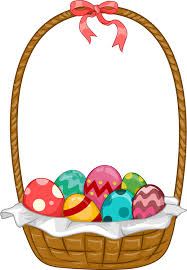http://www.favecrafts.com/Easter/8-Easter-Baskets-to-Make
 |
| Mike Twohy/ The New Yorker Collection 4/12/1993 |
Centuries ago, spring was seen as a time of new life and renewal. An ancient Middle Eastern custom was to take baskets of seedlings to the fertility goddess Eostre to ensure a good harvest. The goddess carried a basket of eggs which represented new life. What we think of as Easter baskets originated in Germany. The Easter Hare would leave baskets of goodies in a "nest" for the children. In the Roman Catholic Church, the tradition of a large Easter meal symbolized the end of Lenten fasting. The feast was brought to the church in baskets to be blessed by the priest.
When I was little, my brother and I were allotted one dozen eggs and a Paas Egg Dying kit. Our eggs always turned out either very pale or grayish. We had the same pretty baskets every year which would usually contain a chocolate bunny and some jelly beans. My son's Easter basket would have candy and, of course, twelve eggs (he is an only child so he got them all) and a small Lego set. He made out like a bandit though when we got to Grandma and Grandpas for Easter dinner. Have a nice relaxing Easter. I have included a link to a site with ideas for making your own Easter baskets.
--Lynn Conaway
| Wow!!! |




